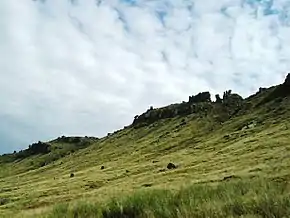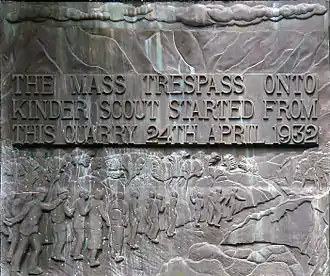Mass trespass of Kinder Scout
The mass trespass of Kinder Scout, also called the Kinder mass trespass,[1] was an act of wilful trespass by ramblers and members of the Young Communist League. It was undertaken at Kinder Scout, in the Peak District of Derbyshire, England, on 24 April 1932, to highlight the fact that walkers in England and Wales were denied access to areas of open country. The trespass was largely organised by Benny Rothman, secretary of the British Workers' Sports Federation (a youth branch of the Young Communist League), in retaliation to the expulsion of the group from Bleaklow three weeks earlier.[2][3]

Events in 1932
The 1932 trespass was a coordinated protest involving three groups of walkers who approached Kinder Scout from different directions at the same time. Accounts of the numbers involved vary widely; a Times article at the time suggested that they numbered about 100, whilst Benny Rothman has claimed the trespass numbered between 600 and 800 and Ewan MacColl has been on record purporting a figure of over 3000.[3][4] The generally accepted figure is that reported by the Manchester Guardian at the time, of an estimated 400 people.[3][5] The trespassers began at Bowden Bridge quarry near Hayfield. It proceeded via William Clough to the plateau of Kinder Scout, where there were violent scuffles with gamekeepers. The ramblers were able to reach their destination and meet with another group at Ashop Head. On the return, five ramblers were arrested, with another detained earlier. Trespass was not a criminal offence in any part of Britain at the time, but some would receive jail sentences of two to six months for offences relating to violence against the keepers.[note 1]
Political effects
According to the Hayfield Kinder Trespass Group website, this act of civil disobedience was one of the most successful in British history. It arguably led to the passage of the National Parks legislation in 1949[7] and helped pave way for the establishment of the Pennine Way and other long-distance footpaths. Walkers' rights to travel through common land and uncultivated upland were eventually protected by the Countryside and Rights of Way Act (CROW Act) of 2000. Though controversial when it occurred, it has been interpreted as the embodiment of "working class struggle for the right to roam versus the rights of the wealthy to have exclusive use of moorlands for grouse shooting."[8]
The Kinder Mass Trespass was one of a number of protests at the time seeking greater access to the moorlands of the northern Peak District. What set it apart from the others was it marked a new and more radical approach to the problem which was not universally popular with rambling groups. The harshness of the sentences imposed on the leaders of the protest was headline news in local and national newspapers, resulting in the issue gaining public attention and sympathy. The subsequent access rally staged in Winnats Pass attracted 10,000 people to attend in support of greater access to the adjacent moorland.[9]
An unintended consequence of the mass trespass was greater interest being paid to ramblers' behaviour and potential ways to regulate it. This resulted in a 'Code of Courtesy for the Countryside' being produced, which was a forerunner of the modern Countryside Code.[10]
Revisionism on the Kinder Scout Trespass
A number of writers have criticised the narrative that hails the Kinder Scout Trespass as being, according to historian David Hey, "a simple explanation of the triumph of the 'right to roam' movement" when, on balance, it did "more harm than good".[3] They point to the real controversy over the Trespass at the time that was commonly used by opponents of the access movement as an argument for denying access even into the 1950s and 1960s which, according to Philip Day of the Manchester Ramblers' Federation, brought a "positive hindrance" to the efforts of the movement.[11] Other writers such as Tom Stephenson have challenged the assertion that the Trespassers had even reached the summit of Kinder Scout and only made it so high as Ashop Head.[12] John K. Walton has questioned the absolutism of this revisionism and advocated for a post-revisionist stance on the Mass Trespass which might acknowledge some of the positive effects that the Trespass' publicity had for the access campaign in both the short term immediacy and its symbolic role in the access campaign over the rest of the century that led to the CROW act.[13]
Commemoration

Poet and folk singer Ewan MacColl (then known by his real name, Jimmie Miller) celebrated these events in his 1932 song "The Manchester Rambler";[4] he had organised the publicity for the trespass. The events form the subject of the song "You Can (Mass Trespass, 1932)" on Chumbawamba's 2005 album A Singsong and a Scrap and inspiration for "Walking in the Footsteps of Giants" by northern folk band Harp and a Monkey.
Each year a combination of wardens and rangers from both The National Trust and the Peak District National Park Authority hold a walking event to mark the anniversary of the trespass.[14] A commemorative plaque marks the start of the trespass at Bowden Bridge quarry near Hayfield, now a popular area for ramblers. It was unveiled in April 1982 by Benny Rothman (then aged 70) during a rally to mark the 50th anniversary.
The Young Communist League hikes up Kinder Scout every year on their annual Communist Summer Camp to commemorate their own involvement in the trespass.[15]
Notes
- "Also they were never charged with the offence of trespass. The charges of unlawful assembly were changed to the more serious charge of riotous assembly. Mr Justice MacKinnon at Chester Assizes in 1933 stated that the Act of Parliament which made it an offence to trespass after being warned not to do so had been repealed, making 'trespassers will be prosecuted' signs unenforceable."[6]
References
Citations
- "Kinder Mass Trespass 'should be taught in schools'". BBC News. BBC. Retrieved 3 November 2014.
- Long, Chris. "How trespassing 'crystallised' Ewan MacColl's songwriting". BBC News. BBC. Retrieved 3 November 2014.
- Hey, David (2011). "Kinder Scout and the Legend of Mass Trespass" (PDF). Agricultural History Review. 59 (2): 210.
- Harker, Ben (Spring 2005). "'The Manchester Rambler': Ewan MacColl and the 1932 Mass Trespass". History Workshop Journal. 59: 219–228, 222. doi:10.1093/hwj/dbi016. S2CID 154501683.
- "Mass Trespass on Kinder Scout". Manchester Guardian. 25 April 1932. Retrieved 26 October 2019.
- "Conflict and Controversy". KinderTrespass.org.uk. Hayfield Kinder Trespass Group. Retrieved 24 April 2019.
- Garrahan, Des (20 November 2019). "Rebel ramblers: The politics of walking". Red Pepper. No. 225. pp. 43–44. ISSN 1353-7024.
- "Kinder Mass Trespass". KinderTrespass.org.uk. Hayfield Kinder Trespass Group. Retrieved 24 April 2019.
- "Description of Trespass – 24 April 1932". KinderTrespass.org.uk. Hayfield Kinder Trespass Group. Retrieved 24 April 2019.
- "The Respectable Reaction – The Manchester Ramblers' Federation and the Kinder Mass Trespass 1932". History at Keele University. Retrieved 20 December 2017.
- Howlett, David (2002). The Pioneer Ramblers; 1950-1940. North Wales Area: Ramblers' Association. p. 193.
- Stephenson, Tom (1989). Forbidden Land: The Struggle for Access to Mountain and Moorland. Manchester: Manchester University Press. p. 153.
- Walton, John K. (2013). "The Northern Rambler: Recreational Walking and the Popular Politics of Industrial England, from Peterloo to the 1930s". Labour History Review. 78 (3): 264. doi:10.3828/lhr.2013.14.
- Trespass Trail (PDF), Hayfield Kinder Trespass Group, retrieved 24 April 2019
- "Communist Summer Camp 2019". Young Communist League of Britain. 3 April 2019. Retrieved 14 August 2019.
Sources
- Rothman, Benny. (1982) 1932 Kinder Trespass: Personal View of the Kinder Scout Mass Trespass. Willow Publishing. ISBN 0-9506043-7-2.